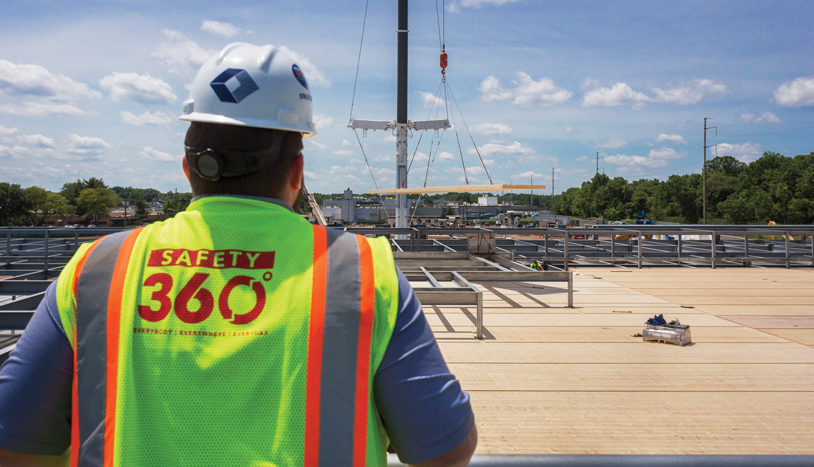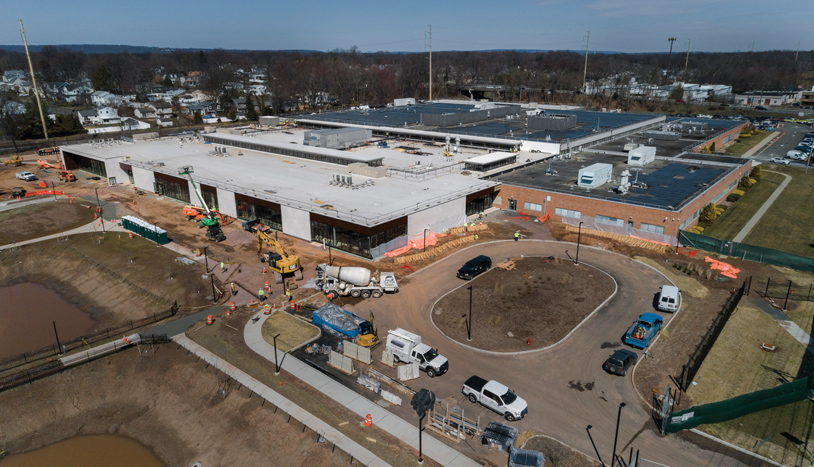Structure Tone New Jersey is diligently constructing L’Oréal’s new, state-of-the-art Research & Innovation (R&I) Center in Clark, NJ. With a $140 million development budget, this project marks the company’s most substantial investment in such a facility to date.
Structure Tone joined the project roster in 2021, managing multiphase construction comprising extensive site work, structural additions of 90,000sf and 10,000sf, and renovation of 135,000sf. As part of the construction, the team is creating new collaboration areas, open office/workstations, a cafeteria, and laboratory spaces featuring various amenities intended to strengthen interdisciplinary partnerships, inspire creativity, and foster collaboration in an innovative work environment.
MASS TIMBER: A SUSTAINABLE BUILDING SOLUTION
Reinforcing the company’s “L’Oréal for the Future” sustainability commitment, L’Oréal’s new R&I Center is designed to the highest sustainability standards by reducing energy use, resource consumption, and waste production while developing multipurpose indoor and outdoor green space to support the area’s ecology and biodiversity.
A key sustainability aspect in terms of construction is the use of mass timber, specifically cross-laminated timber (CLT) decking. As a renewable resource, mass timber is becoming increasingly popular due to the material’s ability to reduce the construction industry’s impact on climate change while satisfying designers’ appetite for biophilic building solutions.

To date, the Structure Tone team installed 82,500sf of 5-ply CLT decking (approx. 6-7/8”) on the main roof deck and 7,500sf of 3-ply (approx. 4-1/8”) on the clerestory sections. The reason for different thicknesses comes down to structural requirements and plans for potential expansion; if additional stories or columns are added to the roof in the future, then the 5-ply can provide the required structural floor support.
With mass timber still gaining traction in tri-state area construction, this was the first time working with CLT for several trades. Therefore, the team relied on experienced subcontractors for guidance. “We subcontracted with a mass timber contractor, Nordic Structures (headquartered in Montreal), to furnish and install,” says Structure Tone project executive Dave Adams. “They fabricate their own product, but subcontracted through a local erector.”

OVERCOMING CHALLENGES WITH MASS TIMBER
Since mass timber was somewhat new to the team, analyzing, solving, and documenting the challenges became critical. One concern centered on adding supplemental steel at the edges of CLT planks. Nordic mandates that their team is on-site to make any duct/pipe penetration over three feet. Bringing a subcontractor into the field to do this is costly, so all MEPS coordination needed to be completed prior to plank fabrication.
Staining the exposed underside of the CLT also proved tricky. The fabricator doesn’t have the manufacturing area for laydown, application, and drying panels before stacking on flat beds for delivery, but staining panels after putting them up can be difficult unless ambient conditions are just right.
“In a perfect world, the team would wait for the roof to be on with complete temperature and humidity control, stain the CLT panels, then move on to the next sequence of work,” Adams describes. “But to keep the project on schedule, we needed to hang the MEPS systems, so we delayed staining the CLT until after we installed the infrastructure.”
To make matters slightly more complicated, the exposed steel is painted a different color than the CLT panels. “Once the MEPS systems are in place, it becomes tough for the team to mask or protect the CLT while we spray the MEPS and steel,” explains Adams. “Eventually, we had to limit spraying, determining that we needed to hand paint most of the steel to avoid discoloring the decking.”
EMBRACING INNOVATION AND GROWTH
Although there has been a slight learning curve for the team with CLT, the takeaway so far is that it will be worth it. For L’Oréal, sustainability was the primary motivation for using CLT—and there are plenty of potential environmental benefits, from reducing emissions to sustainable sourcing to reducing waste. For Structure Tone New Jersey, the journey matters as much as the result.
“We are proud to work with L’Oréal in creating a space that reflects the Company’s dedication to responsible innovation,” says Adams. “We share these values and will undoubtedly apply the insights gained from this experience to our future projects.”
L’Oréal’s new R&I Center is expected to be fully operational in 2024.
